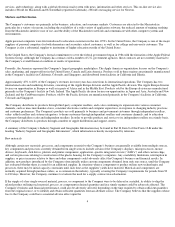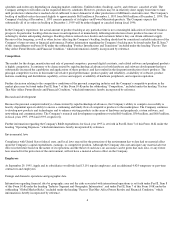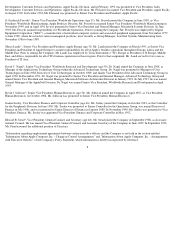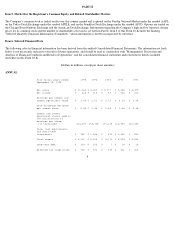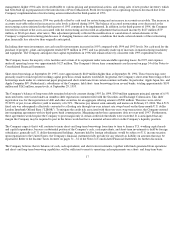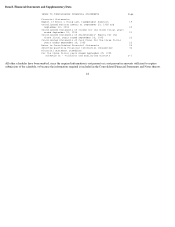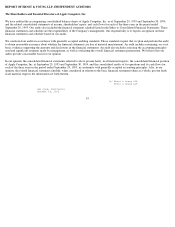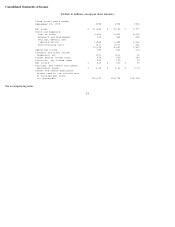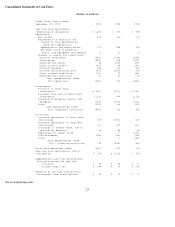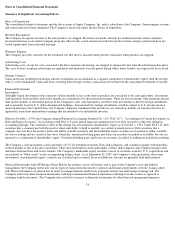Apple 1995 Annual Report Download - page 16
Download and view the complete annual report
Please find page 16 of the 1995 Apple annual report below. You can navigate through the pages in the report by either clicking on the pages listed below, or by using the keyword search tool below to find specific information within the annual report.the ultimate effect that licensing of the Macintosh operating system will have on its product pricing and unit sales or future operating results
and financial condition. The Company believes that licensing the operating system will result in a broader installed base on which software
vendors can develop and provide technical innovations for the Macintosh platform. However, there can be no assurance that the installed base
will be broadened by the licensing of the operating system or that licensing will result in an increase in the number of application software titles
or the rate at which vendors will bring to market application software based on the Macintosh operating system.
The Company's principal competitor in producing operating system software, Microsoft Corporation, is a large, well-financed corporation
which has a dominant position in various segments of the personal computer software industry. In August 1995, Microsoft Corporation
released Windows 95, another of its operating system offerings. As a result of the introduction of Windows 95, the Company has taken and will
continue to take steps to address the additional challenges to and competitive pressures on its efforts in developing and marketing the
Company's products. Accordingly, the Company's future operating results and financial condition could be adversely affected should the
Company be unable to effectively manage the competitive pressure and other challenges presented by the introduction of Windows 95.
Certain of the Company's personal computer products are capable of running application software designed for the MS-DOS or Windows
operating systems ("Cross-Platform Products"), through software emulation of Intel Corporation microprocessor chips by use of software
specifically designed for the Company's products, either those based on the Motorola 68000 series of microprocessors or those based on the
PowerPC microprocessor. The Company has also introduced products that include both the RISC- based PowerPC 601 microprocessor and the
486 DX2/66 microprocessor, which enable users to switch between the Macintosh and DOS or Windows computing environments.
The Company currently supplies customers who purchase Cross-Platform Products capable of running the MS-DOS or Windows 3.1 operating
system with operating system software under a licensing agreement with Microsoft. This license agreement expires on December 31, 1995 (the
"Old License Agreement"). The Company has attempted to license Windows 95 software from Microsoft but has been unable to do so because
of the Company's unwillingness to consent to Microsoft's demand under Microsoft's proposed license agreement (the "New License
Agreement") that the Company agree not to sue Microsoft if Microsoft infringes any of the Company's patents. Microsoft has also informed the
Company that it will not renew the Old License Agreement unless the Company accepts the New License Agreement. Accordingly, unless an
appropriate licensing agreement is reached, upon the expiration of the Old License Agreement, the Company will be unable to supply
customers with any of Microsoft's operating systems on Cross- Platform Products. Although customers could obtain copies of such software
from other sources, the Company is unable to predict the effect of such a situation on the demand for Cross-Platform Products. Although
Cross-Platform Products represented only a small portion of the Company's unit sales during 1995, the Company is unable to predict the effect
of such a situation on the Company's future operating results.
Decisions by customers to purchase the Company's personal computers, as opposed to MS-DOS or Windows-
based systems, are often based on
the availability of third-party software for particular applications. The Company believes that the availability of third-
party application software
for the Company's hardware products depends in part on the third- party developers' perception and analysis of the relative benefits of
developing such software for the Company's products versus software for the larger MS-DOS and Windows market. This analysis is based on
factors such as the relative market share of the Company's products, the anticipated potential revenue that may be earned, and the costs of
developing such software products. Microsoft Corporation is an important developer of application software for the Company's products.
Accordingly, Microsoft's interest in producing application software for the Company's products may be influenced by Microsoft's perception of
its interests as an operating system vendor.
The Company's ability to produce and market competitive products is also dependent on the ability of IBM and Motorola, Inc., the suppliers of
the PowerPC RISC microprocessor for certain of the Company's products, to continue to supply to the Company microprocessors that produce
superior price/performance results compared with those supplied to the Company's competitors by Intel Corporation, the developer and
producer of the microprocessors used by most personal computers using the MS-
DOS and Windows operating systems. IBM produces personal
computers based on the Intel microprocessors as well as on the PowerPC microprocessor, and is also the developer of OS/2, a competing
operating system to the Company's Macintosh operating system. Accordingly, IBM's interest in supplying the Company with improved
versions of microprocessors for the Company's products may be influenced by IBM's perception of its interests as a competing manufacturer of
personal computers and as a competing operating system vendor.
The Company's future operating results and financial condition may also be affected by the Company's ability to successfully expand and
capitalize on its investments in other markets, such as the markets for Internet services and personal digital assistant (PDA) products.
14


